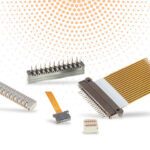Connector Solutions Simplify Design of Wearable Devices
Compact wearable devices often lack sufficient PCB space for the additional hardware that increases device capabilities. Hybrid connectors offer a solution.
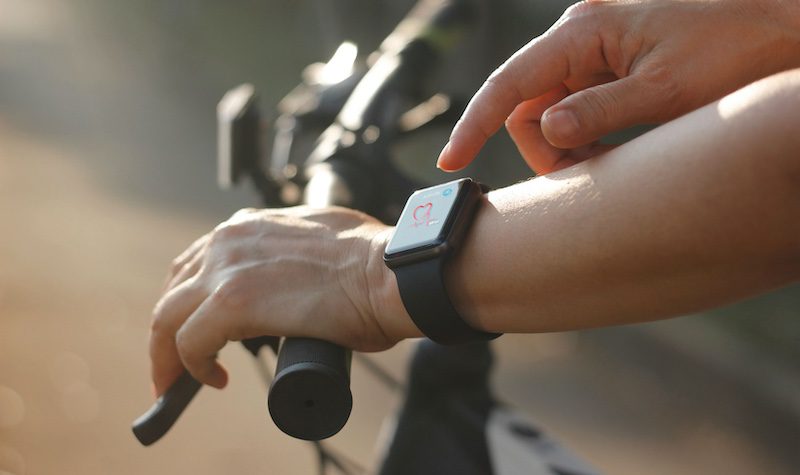
Woman cyclist hands with heart rate icon on smart watch, bicycle at summer trail. All on screen are design up.
Consumers desire sleek and comfortable wearable electronics with reliable performance and a long battery life. However, compact wearable devices often lack sufficient PCB space for the integration and mating of systems such as display modules, touch panel modules, microprocessors, and batteries. Connectors used for wearables can also be limited by form and function constraints. Flip lock zero insertion force (ZIF) and miniature board-to-board (BtB) connectors have been the default choice for many wearable devices but OEMs are now seeking new connectors to keep pace with demands for miniaturization and increased functionality.
Connector technologies
Traditionally, two types of connectors have been used to connect boards via flex in connected wearable device designs. Both connector types have certain advantages and disadvantages.
- Flip lock ZIF connectors feature a flex that is inserted into the connector with one hand; the other hand is used to flip the actuator to close and lock it. They come in both front flip lock and back flip lock styles. They offer easier assembly than slide lock ZIFs, but users still touch the actuator, which increases the risk of damage. Flip lock ZIFs offer high retention forces, provide horizontal mating, and have more options in terms of size and pitch. They have been optimized for the mobile space, but two-handed operation is a drawback.
- BtB connectors are two-piece systems that provide easy one-handed mating by guiding the plug into the receptacle and simply pressing down. BtB connectors offer easy assembly, high retention forces, and many sizes and pitches. They only support vertical mating, but they are a very popular choice in mobile devices when vertical access is available.
Design challenges
As the complexity of wearable devices increases, the challenge for connector selection is balancing space requirements while addressing performance and assembly.
Designers need to consider electrical and mechanical factors, as well as operation and mating ability. For example, placing multiple components on a PCB requires layering flexes and connectors, and this may impact assembly order or require mating in tight spaces.
Previously, stacked board or encased modular systems were used to add more functionality to space-constrained designs. However, many modern connected wearable devices feature reduced form factors in the X, Y, and Z directions. These miniature designs do not allow sufficient Z height for vertical mating of board-to-flex connectors, or even enough access for the manual closing of the actuator on ZIF flex connectors. Vertical stacking of components can also create assembly complications.
As connected consumer and medical wearable devices become more sophisticated, they also require higher speed communication and data processing capabilities, which in turn require superior EMI protection. Connectors that enable high power for fast charging and wireless charging are also in demand.
Wearable devices operate in harsh environments. Waterproof IP67-rated connectors offer excellent protection. Furthermore, drop-impact and vibration are common in wearable device applications. To withstand the rigors of assembly and usage without accidental unmating, the mating connection must be sufficiently rugged and robust. Connectors that maintain high retention force on the flex, but reduce the space needed for a manual mating process can allow more flexibility in the application design.
Other concerns include actuator damage (a common failure mode for ZIF connectors), reducing mating cycle time, and considerations for robotic assembly technologies.
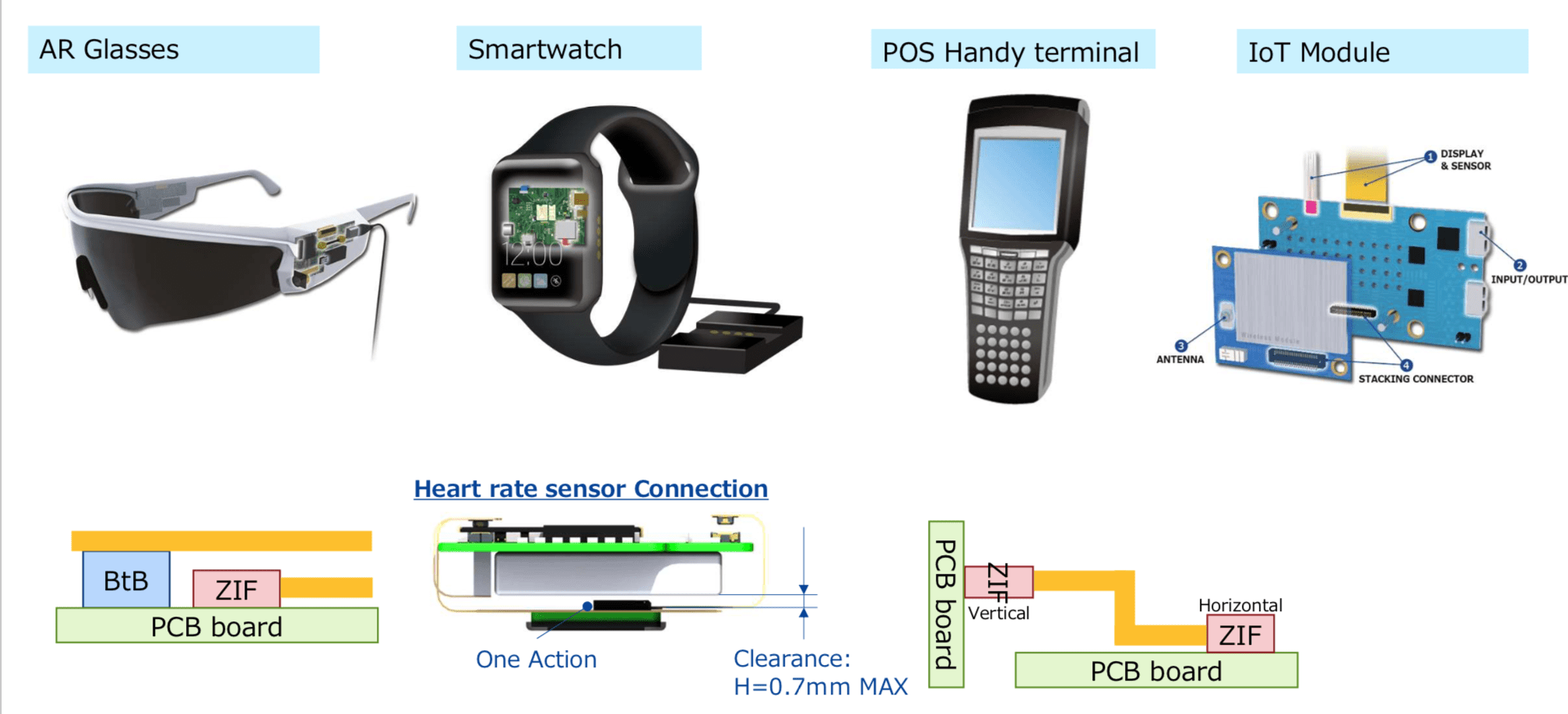
Wearable device designs
Solutions
Hybrid connectors play a crucial role in facilitating communication and power transfer between different components. Combining signal and power into one multi-functional connector enables manufacturers to add more functionality to wearable device designs, without sacrificing size or performance.
Wearable devices often include various components such as sensors, displays, batteries, microcontrollers, and communication modules. These components may require different types of connections, including power, data, and signal connections. Hybrid board-to-board connectors allow for these various connections to be consolidated into a single connector, saving significant PCB space and simplifying the design. A shielded housing ensures high-speed transmission capabilities and noise prevention.
Using separate connectors for power, data, and signal connections can lead to a complex web of cables and connectors. Hybrid connectors streamline manufacturing and assembly by reducing the number of individual connectors that need to be soldered or attached to the PCB. This can lead to faster assembly times and potentially lower manufacturing costs.
Wearable devices may need to communicate with other devices, such as smartphones, tablets, or computers. Hybrid connectors can include standard interfaces like USB, HDMI, or other standards, ensuring compatibility and interoperability. For example, the micro BM29 Series hybrid BtB connector supports USB4 Gen2 (10 Gb/s) transmission.
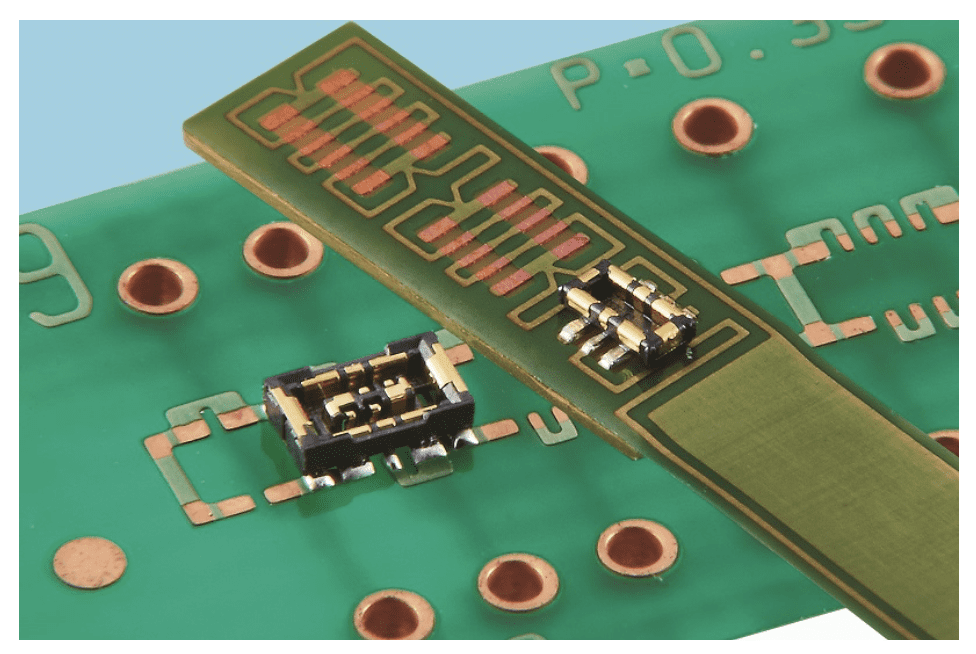
Hirose Electric is among the few companies developing innovative multifunctional connectors. With a 0.35mm pitch, 0.6 mm height and a width of 1.5 mm, BM29 Series is the world’s smallest board-to-board connector.
Hybrid connectors can be designed and configured to meet the specific requirements of a wearable device. This includes selecting the types and number of connections, as well as considering factors like impedance matching, signal integrity, and power distribution.
Benefits of hybrid connectors
- Multi-functionality
- Space efficiency
- Flexible design
- Reduced interconnection complexity
- Reliability and durability
- Quick and easy assembly
- Interoperability
- Customization
- Power management
One-action ZIF connectors simplify the mating process (easy mating with only one hand), while keeping the benefits of the actuator-style ZIF connectors (improved retention force and the ability to unmate the connector via the actuator). One-action ZIF-style flex connectors allow flex insertion without the need to engage an actuator, while still maintaining retention force on the flex.
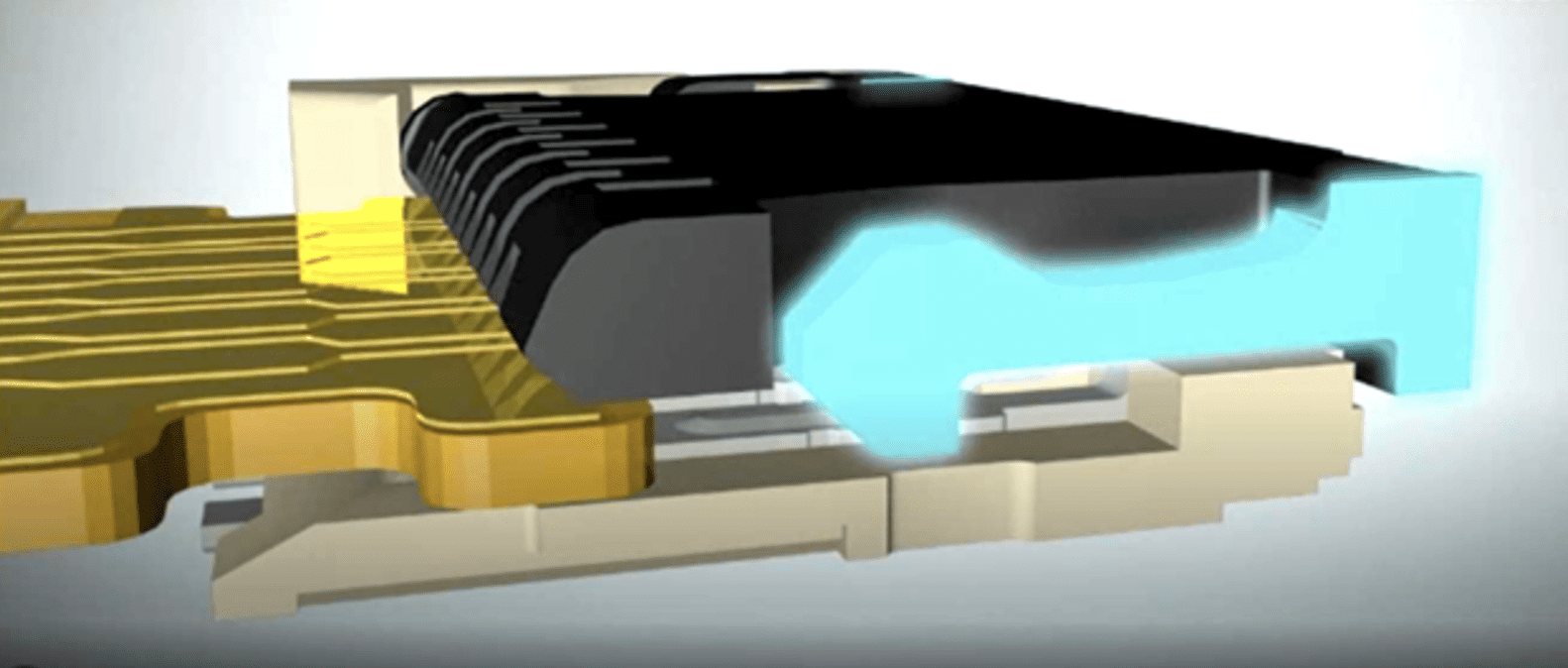
Hirose’s One Action FH design offers low insertion with high retention force.
Flip lock ZIF connectors present the possibility of actuator damage due to operator error during the mating process. The One Action actuator is natively closed, thereby eliminating risk of damage during transport and reducing the possibility of user damage.
One Action connectors, like the FH Series, offer simplified mating in space constrained designs. The One Action allows for contactless mating in tight spaces. On average, the mating time for a typical front style flip lock connector is about 3 seconds. The One Action connector greatly simplifies the mating process and reduces the average mating time to 1 second or less. For high volume production by trained operators, this simplified process saves both time and money. To unmate the system, the actuator can be popped open from the back side to release the side locks; the flex can be pulled out with zero retention force. Watch a video to see it in action.
Finally, the contactless mating process of the One Action connector lends itself to the possibility of robotic assembly. The robot can grab the flex and insert it into the One Action connector without the need for human hands.
Benefits of One Action connectors
- Simplification of the assembly process
- Horizontal mating
- Excellent retention force due to the side hooks
- Mating without touching the actuator
- Reduced chances of damage before and during mating
- Small form factor of the low profile flip lock ZIFs
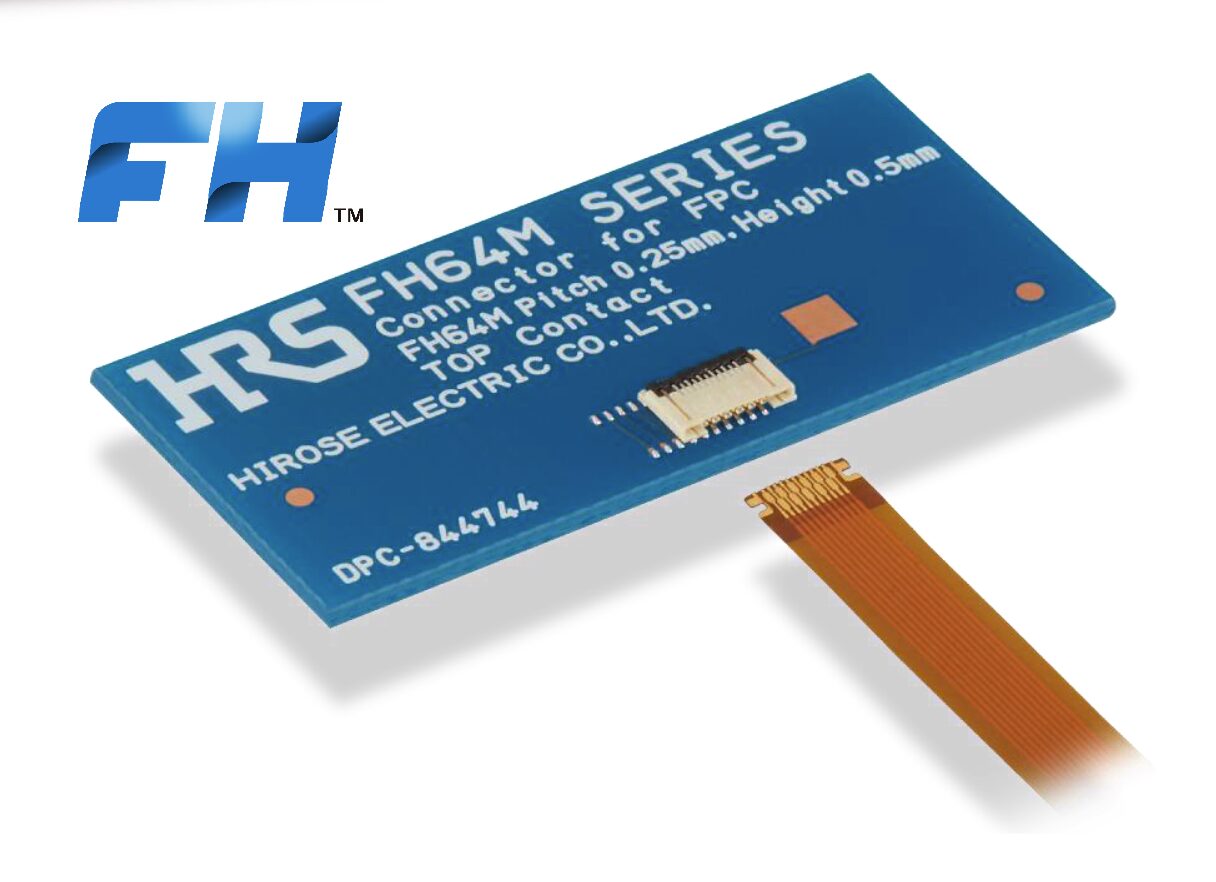
With a 0.25mm pitch, 0.5 mm height, and a width of 3.15 mm, the space-saving FH64MA Series is the world’s lowest-profile ZIF connector
Ultra-small, low profile connectors with high-speed transmission capability dramatically increase the design flexibility of wearable devices. New connector technologies, such as One-action ZIF and hybrid BtB connectors, contribute to efficient space utilization, simplified assembly, reliability, and better overall performance of the wearable device.
To learn more, visit Hirose Electric Americas.
Like this article? Check out our other articles on Wearables, our Consumer Market Page, and our 2023 and 2024 Article Archives.
Subscribe to our weekly e-newsletters, follow us on LinkedIn, Twitter, and Facebook, and check out our eBook archives for more applicable, expert-informed connectivity content.



